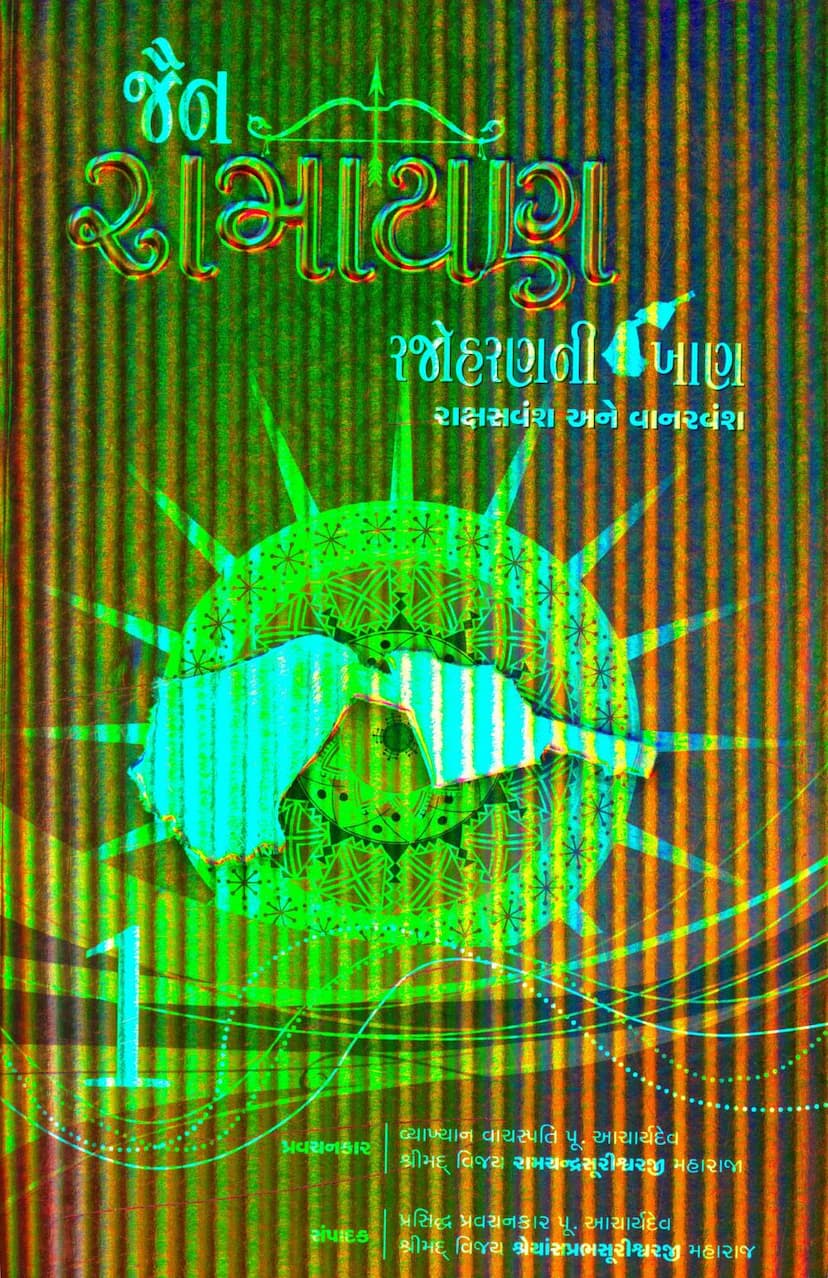Jain Ramayan Part 01
Added to library: September 2, 2025

Summary
This document is the first part of the "Jain Ramayan" series, titled "Rakshas Vansh ane Vanar Vansh" (Demon Lineage and Monkey Lineage), published by Smrutimandir Prakashan. It's based on the discourses of Acharyadev Shrimad Vijay Ramachandrasurishwarji Maharaj, compiled and edited by Acharyadev Shrimad Vijay Shreyansprabhsurishwarji Maharaj.
Here's a summary of the key themes and content presented:
Core Theme: The Jain Perspective on the Ramayana
- Difference from Other Ramayanas: The text explicitly states that the Jain Ramayana significantly differs from other versions. While other Ramayanas often portray Ravana as a demon, base, wicked, and lustful, the Jain Ramayana presents him as a virtuous and righteous soul who abstained from defiling other women. An example cited is Ravana's anger towards Vibhishana for opening the city gates due to temptation by Nalakuver's wife, which showcases Ravana's adherence to virtue.
- Focus on Jain Principles: The Jain Ramayana emphasizes Jain teachings, principles, and the philosophical underpinnings of events. It highlights the importance of renunciation, spiritual discipline (samyam), and the path to liberation (moksha).
- "Rajo-haranam ni Khan" (Mine of Rajo-haranam): The title itself suggests a deep connection to the concept of Rajo-haranam, which in Jainism refers to the shedding of karmic matter, a crucial aspect of spiritual progress. The Ramayana narrative is presented as a source for understanding this shedding of karma.
Key Content and Figures:
- The Ramayana as a "Mine of Diksha" (Diksha ni Khan): The narrative is presented as a rich source for understanding and inspiring the path of renunciation (diksha) and spiritual discipline.
- Contrasting Narratives: The text contrasts the Jain portrayal of characters like Ravana with other traditions, emphasizing Ravana's virtuous nature and self-control.
- Genealogy and Origins: The first part delves into the origins of the Rakshasa and Vanara lineages, tracing them back to King Dhanvahan during the era of the 2nd Tirthankar, Lord Ajitnath. It describes the lineage leading up to Ravana's birth.
- Character Analysis and Moral Teachings:
- Ravana: Portrayed as a virtuous and righteous soul, a proponent of dharma, and a strong advocate for his lineage and principles. His devotion to Jain Tirthankaras and his efforts to uphold dharma are highlighted. His encounters, like the one with Vibhishana and his subsequent adherence to righteousness, are presented as evidence of his character.
- Vali: Depicted as a righteous king (Rajrishi) and a hero who, after his defeat by Ravana, embraces the path of renunciation and achieves liberation. His wisdom, restraint, and devotion are emphasized.
- Hanuman: The chapter on Hanuman's origin highlights the story of Anjana Sundari and her virtuous life, and how even in adversity, her devotion remains steadfast.
- Shreyanshakara Sri Ahaddas and King Shrenik: An anecdote illustrates true benevolence and how a righteous ruler like King Shrenik values and supports true devotion to Jain principles, even when it means setting aside worldly festivities.
- The Influence of Parents and Upbringing: The text touches upon the impact of parental teachings and upbringing on a child's spiritual journey, contrasting the ideal with flawed examples.
- Emphasis on Jain Philosophy:
- Karma and Rebirth: The text implicitly touches upon the concept of karma and how actions in past lives influence current circumstances.
- The Importance of True Devotion: The narrative emphasizes that true devotion is not just outward ritual but a state of internal commitment and virtue.
- Renunciation (Diksha): The concept of renunciation is presented as a central theme, exemplified by several characters choosing the spiritual path over worldly pleasures.
- Moral and Ethical Guidance: The stories are designed to provide moral and ethical guidance, illustrating the consequences of actions and the importance of righteous conduct.
- Historical and Spiritual Context: The discourses are rooted in Jain scripture, particularly referencing the "Trishashti Shalaka Purush Charitra" by Acharya Hemachandrasurishwarji Maharaj, specifically the 7th chapter dealing with the Ramayana narrative.
- The Role of Gurus and Spiritual Teachers: The importance of gurus and the lineage of spiritual teachers (Suri, Acharya) is highlighted throughout, underscoring the transmission of Jain knowledge and principles.
Overall Tone and Purpose:
The book aims to present the Ramayana narrative through a Jain lens, highlighting its spiritual and ethical dimensions, and emphasizing the path of renunciation and liberation. It seeks to educate readers about Jain philosophy and its unique interpretation of widely known stories, portraying characters like Ravana and Vali in a more positive light compared to other traditions, focusing on their adherence to Jain principles and their ultimate spiritual journeys. The compilation of these discourses aims to make the profound teachings accessible to a wider audience.